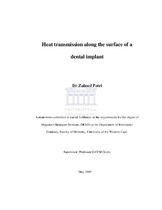| dc.contributor.advisor | Geerts, Greta A. V. M. | |
| dc.contributor.author | Patel, Zaheed | |
| dc.contributor.other | Dept. of Restorative Dentistry | |
| dc.contributor.other | Faculty of Dentistry | |
| dc.date.accessioned | 2014-01-16T13:37:09Z | |
| dc.date.available | 2011/07/18 13:52 | |
| dc.date.available | 2011/07/18 | |
| dc.date.available | 2014-01-16T13:37:09Z | |
| dc.date.issued | 2009 | |
| dc.identifier.uri | http://hdl.handle.net/11394/2597 | |
| dc.description | Magister Chirurgiae Dentium - MChD | en_US |
| dc.description.abstract | Objectives: Temperature changes along an implant body have not been widely studied. The objectives of this in vitro study were (i) to establish if the temperature of the abutment influences the temperature of the implant surface, (ii) to establish the temperature transmission from abutment to implant body, and (iii) to establish for what abutment temperature the critical time/temperature threshold of 47oC for 1 minute at implant level is reached. Materials and method: Eight K-type thermocouples were attached to an
abutment/implant configuration, mounted in a thermostatically controlled
environment. The abutment was exposed to hot water. The temperature at each thermocouple along the implant was logged over a maximum period of 10 minutes using appropriate software. The test was repeated 200 times. A logistic regression model was used for the analysis of the time/temperature databases. Results: There was a positive correlation between the temperatures of the implant and its abutment, albeit with a time delay. Critical threshold values for bone necrosis were reached. The effective dose 50 was estimated at 62.3oC (95% confidence interval estimate): for an abutment temperature of 62.3oC there is a 50% chance that 47oC for 1 minute at implant level is reached. Conclusion: The results of this in vitro study support the hypothesis that abutment temperature is transmitted to a dental implant body. Results of in vitro studies should be interpreted with caution. However, clinicians should be aware of temperature changes along implants and the potential risk associated with this. | en_US |
| dc.language.iso | en | en_US |
| dc.publisher | University of the Western Cape | en_US |
| dc.subject | Dental implants | en_US |
| dc.subject | Heat transmission | en_US |
| dc.subject | Thermocouple | en_US |
| dc.title | Heat transmission along the surface of dental implant | en_US |
| dc.type | Thesis | en_US |
| dc.rights.holder | University of the Western Cape | en_US |
| dc.description.country | South Africa | |

